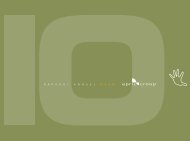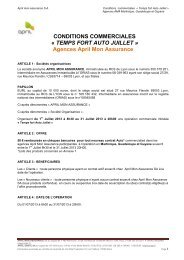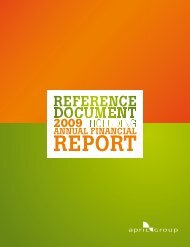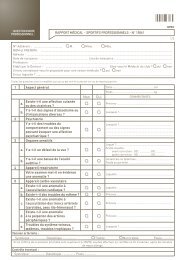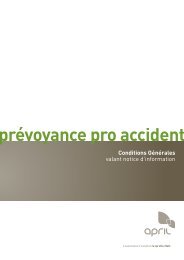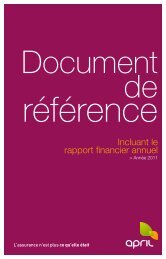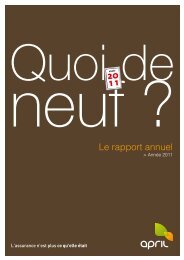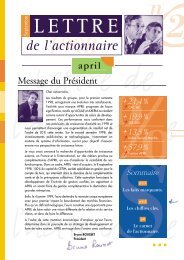2007 - April
2007 - April
2007 - April
Create successful ePaper yourself
Turn your PDF publications into a flip-book with our unique Google optimized e-Paper software.
2.0<br />
Notes to the consolidated financial statements at December 31 st <strong>2007</strong><br />
Furthermore, APRIL GROUP is a founding member of the<br />
micro-insurance association “Entrepreneur dans la Cité”,<br />
paying in 500 thousand euros in this respect over <strong>2007</strong>.<br />
Note 9. Financial and insurance risk management<br />
9.1. Classification of risks under IFRS 7 and IFRS 4<br />
9.1.1. Financial risks<br />
IFRS 7 recognizes the following categories of financial risks:<br />
Market risk: this risk can be broken down into the foreign<br />
exchange risk, fair value risk on fixed-rate financial<br />
instruments, and value risk on listed instruments;<br />
Credit risk: this corresponds to the risk of default by<br />
an issuer or counterparty, i.e. the risk for a creditor of<br />
definitively losing their debt insofar as the debtor will be<br />
unable, even by liquidating all of its assets, to pay back all<br />
of its commitments;<br />
Liquidity risk: this concerns the risk of not being able to<br />
sell a financial instrument at a value close to its fair value.<br />
It may result in it effectively being impossible to sell the<br />
instrument (absence of market, buying counterparty), or in<br />
an illiquidity discount;<br />
Cash-flow risk linked to interest rates: for variable-rate<br />
financial instruments, changes in rates imply changes in the<br />
company’s future cash-flows.<br />
9.1.2. Insurance risk<br />
Under IFRS 4, policies must be classified as either insurance<br />
policies or investment policies.<br />
IFRS 4 specifies that a policy is classified as an insurance<br />
policy if it exposes the insurance company to an insurance<br />
risk, which corresponds to a non-financial risk taken on by<br />
the insurer.<br />
9.2. Brokerage<br />
9.2.1. Nature of associated risks<br />
The Group’s brokerage companies are exposed to the<br />
financial risks presented in Section 9.1.<br />
9.2.2. Management of brokerage risks<br />
Through its financial model, where cash-flow generates<br />
a negative working capital requirement, the brokerage<br />
business enables the Group to achieve a very low level of<br />
debt, reducing the volume of financial liabilities exposed.<br />
The cash-flow generated by the Group’s brokerage companies<br />
is fully invested in short-term financial investments, primarily<br />
through the APRIL Trésorerie mutual fund. The APRIL<br />
Trésorerie mutual fund represents a fund of funds, equivalent<br />
to a cash-based UCITS (“monetary equivalent”), and therefore<br />
involves zero capital risk and very low volatility.<br />
9.2.3. Analysis of sensitivity<br />
The income generated by cash-flow from the Group’s<br />
brokerage companies is therefore sensitive to changes in the<br />
benchmark monetary rate: EONIA. For reference, a 100 basis<br />
point change in the EONIA on average over <strong>2007</strong> would have<br />
had an impact on the Group’s financial result representing<br />
1,105 thousand euros.<br />
9.3. Insurance companies<br />
9.3.1. Nature of associated risks<br />
Companies are exposed to financial risks in terms of both<br />
the financial assets that they hold and the financial liabilities,<br />
including investment policies, that they take out.<br />
They are exposed to the insurance risk through the portfolios<br />
of insurance policies that they hold.<br />
The Group is present on the health, personal protection and<br />
property and casualty insurance sectors through a portfolio<br />
of insurance policies, the main characteristics of which are<br />
as follows:<br />
Short risk, for a low unit amount, with high frequency,<br />
High level of expertise,<br />
Internalized management strategy.<br />
Underwriting provisions relating to insurance policies are<br />
valued in line with the methods traditionally used and in<br />
accordance with the French Insurance Code based on various<br />
statistical and actuarial processes.<br />
138<br />
Return to the contents section



